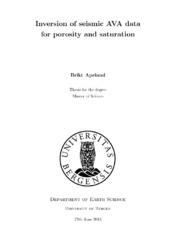Inversion of seismic AVA data for porosity and saturation
Master thesis
Permanent lenke
https://hdl.handle.net/1956/15835Utgivelsesdato
2013-06-27Metadata
Vis full innførselSamlinger
- Department of Earth Science [1050]
Sammendrag
Rock physics serves as the link between reservoir parameters and the effective elastic reservoir properties, and Amplitude Variation with Angle (AVA) modelling serves as the link between elastic properties and reflection coefficients. AVA inversion is one of the techniques that is being used to estimate sub-surface physical parameters such as saturation and porosity. A non-interacting compliance model is used to find the effective elastic parameters of the dry rock. Woods equation is then used along with Gassman-Biot theory to calculate the effective elastic parameters of a fluid saturated rock. This information is used as input for AVA modelling from elastic properties to reflection coefficients using the Zoeppritz equations or Aki-Richards approximation. The modelling error introduced by Aki-Richards approximation is investigated for two-layer models that differ according to reservoir models with varying saturations and porosities. Further, the effect of this modelling error is investigated in a one-step unbiased inversion algorithm from AVA data to saturation and porosity. Also, the implications of assuming constant crack density in a spatial varying reservoir is investigated. Inversion tests indicate that Aki-Richards approximation may give valid porosity estimates in a less computationally expensive manner than the Zoeppritz equations. A time-continuous formulation of Aki-Richards approximation is adopted for AVA modelling from a stratified earth model with a reservoir section. It is used along with the rock physics model in two-step inversion algorithms. The first step is from AVA data to the elastic properties of the stratified earth models and the second step is from effective elastic reservoir properties to saturation and porosity. Well logs may serve as additional information as prior models into the inversion algorithms. Two-step inversion algorithms with prior models within the framework of both a frequentist and Bayesian interpretation of probability theory are demonstrated.
